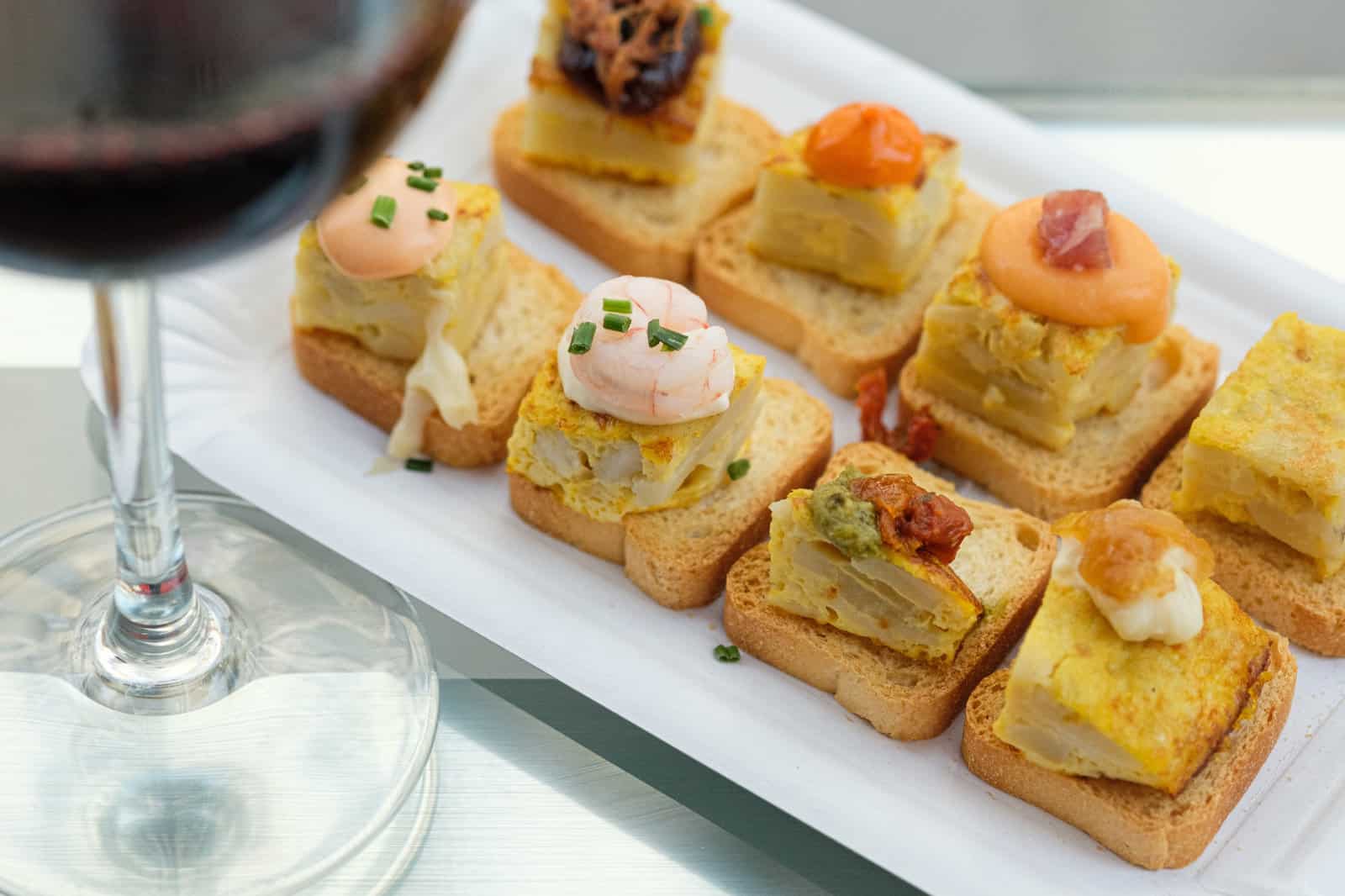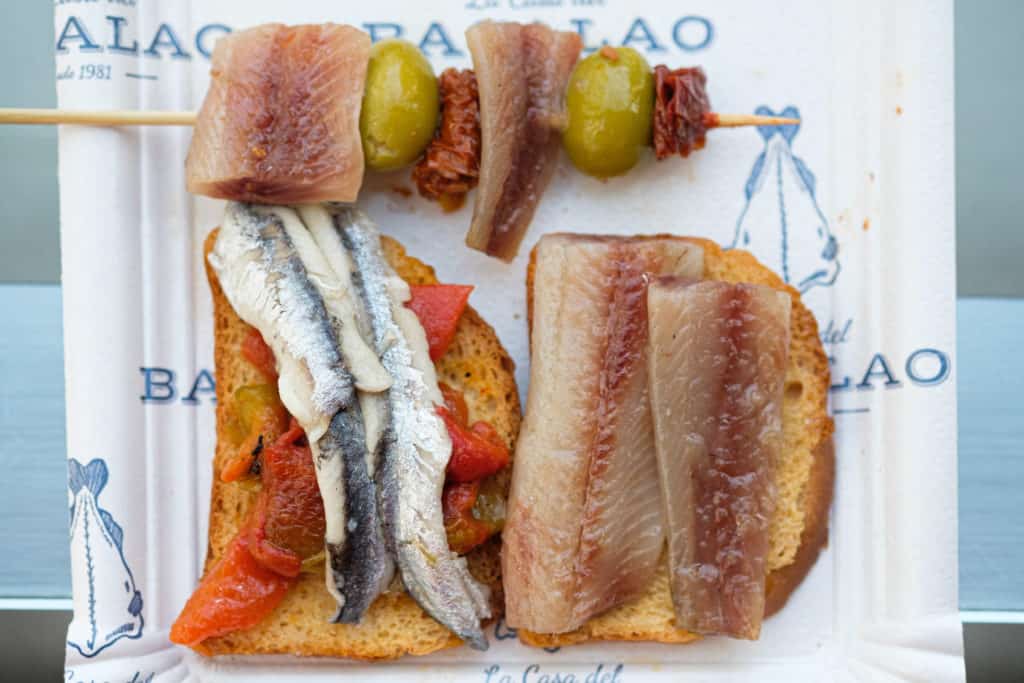
Photography by Galdones Photography
The concept of the free snack in American culture runs the gamut from dive bars to white tablecloth restaurants, places where the phrases “happy hour” and “amuse bouche” translate to small, often tasty snacks or nibbles, whether salted popcorn in a bar or more elaborate bites prepared by a restaurant is an offering, a way of saying welcome at no charge.
In the United States, you will not find such “gifts” at wine bars or at most restaurants when ordering a glass of wine, but in many parts of Spain, the opposite is true. In Southern Spain, order a copa de vino, and chances are a complimentary tapa will accompany your glass of wine. This can take the form of a dish of olives, a small bowl of potato chips, a few slices of chorizo or perhaps a small dish of paella. If this offering has a name at all (in Spain, this type of nibble is served without pretense or name), it will likely be called a tapa – a small bite meant to be eaten with wine.
A lesser-known fact is the word “tapa” comes from the Spanish verb tapar, meaning “to cover.” This comes from a time when the barkeep would put a slice of cheese or ham on a small plate and set it on top of the customer’s glass. This served as a cover just in case any nearby fruit flies wanted a sip of their own.
If you’re in Basque Country in Northeastern Spain, this type of wine accompaniment might come in the form of a pintxo – an individually portioned open-faced sandwich or skewer of ingredients traditionally stacked and held together with a stick or toothpick. The word pintxo itself underscores this as it comes from the Spanish verb “pinchar,” meaning to stick or to puncture.
One thing is true: whether you call it a pintxo, tapa, or bar snack, these have nothing to do with pairings. Instead, they are as much an extension of hospitality as they are an alcohol buffer – the latter, a benefit brought to the fore in the 13th century by King Alfonso X who was made to consume food with alcohol while he was recovering from an illness. He found the combination so satisfying that he ordered alcohol to always be served with food from then on. Whether legend or fact, it makes a good story. Relatable too.


The pintxo meets Hollywood
The “gift” concept inherent in these Spanish small bites is not quite as straightforward as it might seem. Whether or not it’s an actual gift – that is, free — has to do with where it’s being served, what it is, and how big it is.
Pintxo refers to a small individual portion. It can be a small bite or two, a small sandwich that is layered and held together by a toothpick, or fresh ingredients stacked directly onto the toothpick. Legend has it that the original pintxo – a combination of a pickled pepper, oil-cured anchovy, and Manzanilla olive – was invented at a bar in San Sebastián in northeastern Spain. A regular bar patron and wine salesman wanted to come up with a name for the one-bite trio he claimed made his wine taste even better.
Enamored of the film star Rita Hayworth, who was the star and namesake of the movie “Gilda” — a wildly popular movie in Spain at the time – he named his creation the Gilda. He said that like the character, this pintxo was salty, green, and spicy. Maybe not any less important is that these bundles of flavor proved this salesman right as they inevitably led customers to order more drinks and engage in extended frivolity and conversation. The movie went on to claim cult status as did the first commercialized pintxo – the gilda.
Pintxo versus tapa
The colorful and tasty snacks begun in the Basque Country started no less than a movement throughout Spain and beyond – the evolution of beautifully stacked foods and small plates in wine bars. Of course, tapas were already a thing too, just different.
Tapas may be slightly more elaborate than pintxos. The most famous tapa may be the tortilla de patata or thick Spanish “omelet” consisting of eggs, potatoes and sometimes onion served at room temperature.
Not to confuse matters, but tapas may be served in a small portion called a pintxo, natch. They can also be served as a “media” portion – one half of a tortilla (or larger portion of any tapa) – or an entera, a whole portion. These larger portions are referred to as raciónes. In fact, an important distinction between pintxos and tapas is that pintxos are not meant to be shared while tapas are often communal depending on the size.
Tapas might also come in the form of croquetas– fried bites of ham or potatoes (or both) – or maybe tinned anchovies. Or they might be a mini size bocadillo or sandwich. Unlike the pintxo version of a sandwich, which is usually open-faced, bocadillos have a piece of bread on top as well.
When it comes to pintxos, the toothpicks serve a purpose beyond just holding the food together. They’re also how the barkeep keeps track of what the customer has ordered. Although it’s done on the honor system (who’s going to monitor whether a toothpick or two fell on the floor?), the eagle-eyed bartenders have a pretty good idea of how many “sticks” you’ve ordered during your stint at the bar.
Pintxos are usually a great value too – two or three dollars for sizable bites. Never mind the toothpick holding the ingredients in place is just a couple of inches or so. Amazing what a skinny piece of wood can do.
The most important distinction between tapas and pintxos is that pintxos are never free. Tapas may come at no charge when wine is ordered. Even this is changing, though. Free tapas still exist in the southern part of the country – specifically Andalusia and Valencia – but they are likely to cost a little something elsewhere. Wherever these gratis bites are served, they are offerings rooted in hospitality, a way of saying, “Please enjoy this gift with your wine and stay awhile.”
Of course, it may come as no surprise that the free tapa isn’t a completely altruistic gesture. It keeps patrons in their seats (or on their feet) ordering more beverages and food. Or, in the case of “ir de tapas” – a migration of sorts when friends get together and go from tapas bar to tapas bar ordering wine – usually small portions served in shot-like glasses – and ordering a tapa or two before moving on. Here, the bars are providing satisfying bites and sips with no hassle or pretense, and customers are getting in and out the door quickly while having fun along the way.
Ribera and Rueda: A perfect match
In the landlocked region of Castilla y León, the concepts of pintxos and tapas are fortuitous because of the notable and prestigious wines made there — Ribera del Duero Tempranillo and Rueda Verdejo. Both wines love these small bites regardless of whether they’re made with meat, cheese, fish, eggs, or vegetables. Tempranillo especially loves Spain’s most treasured jamón Ibérico as well as aged sheep cheeses while Verdejo harmonizes perfectly with fish, olives, and vegetables.
To be clear, whether it is a tapa, pintxo, gilda, or the less-used term but still pertinent oferta or offering, it is not a pairing concept. Still, there’s no question that it makes wine that much more enjoyable. These small bites are an extension of hospitality. If the food and wine go together, then all the better. Luckily, Ribera Tempranillo (also called Tinto Fino in this region) and Rueda Verdejo do just that.
Meet the micro-tapa
Although tapas have made their way to the U.S., the “free gift” and the hospitality concept behind that has not. At least not yet. This begs the question, what are we waiting for? Are we ready for a movement that embodies both cultures and our drive to welcome people into our business with a glass of wine and a complimentary gift from the bar?
Behold, the micro-tapa – a complimentary small and delicious bite (the behind-the-scenes cost, about 30-50 cents apiece) given to all drink-ordering customers at the bar as a welcome, an encouragement to stay awhile, a palate awakener, an alcohol buffer and, perhaps a subtle invitation to order more food and drink.
No – this is not new in America. We’ve been offering everything from popcorn to peanuts to mini-hot dogs to fried cheese bites for as long as bars have been around. In fact, for a time, bars competed for business by gussying up their free bar bites in an effort to outdo their competitors. No need to do that now, but no one will ever turn down a tasty bite given “on the house” especially when it’s served with amazing wines.
Micro-tapa how-tos
Although there really are no rules when it comes to micro-tapas, it’s helpful to know what a micro-tapa is and is not and how to frame it. Here are some simple guidelines:
- A micro-tapa is free.
- A micro-tapa is the perfect bite with a glass of wine. Whether or not it “pairs” is less important than that it’s a simple and tasty bite that provides a window into both the kitchen’s prowess and the establishment’s welcoming philosophy.
- A micro-tapa doesn’t have the word “micro” in it for nothing. It is small.
- A micro-tapa is served in just two settings: the bar of a restaurant as a means of promoting the relationship between the barkeep, customer, and their glass of wine, or in the communal and social setting of a home, where it is shared by hosts with their guests together with glasses of wine (or beverages of choice).
Ideally, a micro-tapa is served with a glass of red or white wine. It is a gift from the house served on a plate, toothpick or even just a napkin and is meant to be finger food. No utensils needed. - A micro-tapa is not heated. It is a combination of preserved and room temperature-safe foods that hold easily in the fridge, backbar, or kitchen countertop.
- A micro-tapa should be made with common pantry items, whether in the commercial or home setting.
- A micro-tapa can consist of oil- or vinegar-cured and pickled items such as tinned fish, olives, peppers or vegetables, or cheese, ham, eggs, and other proteins and perhaps a cube of bread to soak up the juices from the other ingredients.
- Micro-tapas should be inspiring, humble, and simple combinations and preparations for the restaurant as well as the home entertainer.
Returning to wine talk, specifically Ribera del Duero and Rueda, it behooves all micro-tapas providers to have bottles of Ribera Tempranillo and Rueda Verdejo nearby. The reason is simple: micro-tapas pair perfectly with both these wines. The many flavors in micro-tapas and the various styles of each of these wines ensures that.
Make no mistake: a micro-tapa creates a lasting memory and hopefully becomes a movement you can partake in at your favorite neighborhood wine bar supporting Ribera and Rueda, Spain’s most prestigious wine regions for red and white wines. It inspires loyalty and camaraderie and most of all, a moment in which to give really is better than to receive.




